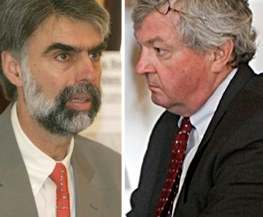Former VT deputy secretary of administration: State’s economy ‘stagnant’

CONFLICTING VIEWS: Secretary of Administration Jeb Spaulding (left) and former Deputy Secretary Tom Pelham (right) don’t see eye-to-eye on Vermont’s economic outlook.
By Bruce Parker | Vermont Watchdog
MONTPELIER, Vt. — While leaders of the Gov. Peter Shumlin administration continue to talk of economic recovery, Vermont’s former deputy secretary of administration says 2014 annual revenue shows the state’s economy has become “stagnant.”
“They’re slapping a smiley face on near stagnant year-over-year revenue growth,” Tom Pelham said of new revenue numbers released by the Department of Finance and Management.
According to the data, General Fund receipts for fiscal 2014 totaled $1,327.53 million — $38.92 million, or 3.02 percent, ahead of fiscal 2013.
Vermont Secretary of Administration Jeb Spaulding called the 3 percent year-over-year increase a “good economic indicator” and “helpful from a budgetary perspective.”
“We are very pleased to end the fiscal year slightly ahead of our economists’ projections and well ahead of last year’s actual performance,” Spaulding said.
But Pelham, who served in three former administrations, including a role as commissioner of finance and management under former Gov. Howard Dean, categorized such talk as “wishful thinking,” saying the state was on a spending binge far beyond what Vermonters can afford.
“In year-over-year actuals, personal income is up 1.56 percent, sales tax is down 0.6 percent, and overall revenues are up just a little over 3 percent. …Now step back and look at next year’s budget. For next year, for the 2015 budget over the 2014 budget, they’re calling for a 6.22 percent General Fund spending increase.”
The gap between what Vermonters can pay and what the Shumlin administration will spend in fiscal 2015 is a departure from the state’s longstanding policy of sustainable spending. As championed by former Governors Jim Douglas and Howard Dean, sustainable spending means a state’s budget increases should not exceed revenue growth in a given year. In 2015, Vermont is on track to spend four times what it brings in.
Those who disagree the state is on the wrong track often cite Vermont’s 3.3 percent unemployment rate as reason for hope. For these economic optimists, low unemployment means Vermont has enough workers to shoulder the burden of future spending increases.
However, a recent analysis of Vermont’s unemployment rate points out that the 3.3 percent figure applies only to Vermonters who have looked for work in the past four weeks. A more inclusive number that counts all unemployed individuals plus part-timers seeking full-time work sets Vermont’s unemployment rate above 9 percent.
Moreover, when it comes to unemployment data, Pelham notes the total number of employed Vermonters has remained flat for seven years, even as spending has risen sharply.
“There was a big drop in unemployment because of the (2008) recession, and Vermont has climbed back out of that hole — so we’re level. But during that same time, the state budget has gone up 30 percent. (Yet) the incomes of Vermonters have not gone up 30 percent, and the number of employees hasn’t gone up 30 percent.”
Pelham says that gap puts Vermont on a crash course with reality. Specifically, the state has the same number of employees making the same amount of money while the cost of government goes up 30 percent.
“There’s a lot of wishful thinking in all of this. They want to make things look as favorable as possible in an election year,” Pelham said.
“I would feel happier if state spending was only going up 2 percent or 3 percent in an environment where revenues are going up 1.5 percent to 2 percent. … But the gap between a 1.5 percent increase in personal income and a 6 percent increase in General Fund spending is a big gap.”
Contact Bruce Parker at bparker@watchdog.org







